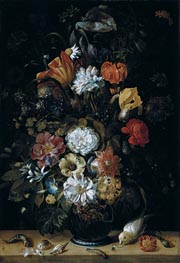Johann Adalbert Angermayer Giclée Fine Art Prints
1674-1740
Bohemian Baroque Painter
Johann Adalbert Angermayer, born in the Bohemian town of Bílina in 1674, carved a space for himself in the tradition of still life painting, particularly the intimate, cabinet-sized compositions that were prized in the Baroque era. His work, while seemingly modest in scale, speaks to a profound engagement with the world of objects - flowers, jewelry, fabrics - rendered with a near obsessive attention to detail. In Angermayer’s hands, still life becomes something more than a showcase of craftsmanship; it becomes a quiet meditation on materiality and time, on the fleeting beauty of the world around us.
After moving to Prague in 1699, Angermayer found a key mentor in Johann Rudolf Byss, a fellow still life artist who had studied in the Netherlands. The influence of the Dutch Fijnschilders is palpable in Angermayer’s work - their precision, their focus on light and texture, and their ability to make the ordinary extraordinary. By 1707, Angermayer had joined Prague’s Old Town Painter Guild, marking his formal integration into the artistic community. But even within these established circles, his work maintained a singular quality. His still lifes - often no larger than 35 cm - were windows into a richly detailed world, each object lovingly rendered as if caught in a moment of suspension.
Angermayer was not content to simply follow the conventions of still life painting. While he did paint the usual subjects of flowers and hunting trophies, his compositions often hinted at a deeper narrative, a sense of life happening just beyond the frame. His still lifes for example, offer not just a study in texture and form but a quiet reflection on time itself. There’s a delicacy to these works, a subtle interplay between the objects that invites the viewer to linger, to consider the relationships between things - between the organic and the man-made, the ephemeral and the enduring.
Although his life was largely centered in Prague, Angermayer’s influence rippled outward through his pupils, such as John Caspar Hirschely and Carl Kastner. His stint working for the Monastery of Osek from 1719 to 1722 further enriched his palette, as religious commissions allowed him to expand his thematic range, though he remained rooted in his fascination with detail. He continued to paint until his death in 1742, leaving behind a body of work that, while often overlooked, offers a unique window into the era’s aesthetic preoccupations.
Johann Adalbert Angermayer’s legacy may not be one of bold innovation or grand narrative, but his intimate studies of the everyday resonate with a quiet strength. His paintings ask us to look closer, to appreciate the textures of life - the way light falls on velvet, the glint of gold, the fragile bloom of a flower. In a world that is increasingly fast-paced, Angermayer’s work offers a moment of stillness, a reminder of the beauty found in the smallest of details.
After moving to Prague in 1699, Angermayer found a key mentor in Johann Rudolf Byss, a fellow still life artist who had studied in the Netherlands. The influence of the Dutch Fijnschilders is palpable in Angermayer’s work - their precision, their focus on light and texture, and their ability to make the ordinary extraordinary. By 1707, Angermayer had joined Prague’s Old Town Painter Guild, marking his formal integration into the artistic community. But even within these established circles, his work maintained a singular quality. His still lifes - often no larger than 35 cm - were windows into a richly detailed world, each object lovingly rendered as if caught in a moment of suspension.
Angermayer was not content to simply follow the conventions of still life painting. While he did paint the usual subjects of flowers and hunting trophies, his compositions often hinted at a deeper narrative, a sense of life happening just beyond the frame. His still lifes for example, offer not just a study in texture and form but a quiet reflection on time itself. There’s a delicacy to these works, a subtle interplay between the objects that invites the viewer to linger, to consider the relationships between things - between the organic and the man-made, the ephemeral and the enduring.
Although his life was largely centered in Prague, Angermayer’s influence rippled outward through his pupils, such as John Caspar Hirschely and Carl Kastner. His stint working for the Monastery of Osek from 1719 to 1722 further enriched his palette, as religious commissions allowed him to expand his thematic range, though he remained rooted in his fascination with detail. He continued to paint until his death in 1742, leaving behind a body of work that, while often overlooked, offers a unique window into the era’s aesthetic preoccupations.
Johann Adalbert Angermayer’s legacy may not be one of bold innovation or grand narrative, but his intimate studies of the everyday resonate with a quiet strength. His paintings ask us to look closer, to appreciate the textures of life - the way light falls on velvet, the glint of gold, the fragile bloom of a flower. In a world that is increasingly fast-paced, Angermayer’s work offers a moment of stillness, a reminder of the beauty found in the smallest of details.
2 Johann Adalbert Angermeyer Artworks

Giclée Canvas Print
$54.63
$54.63
SKU: 4263-AAJ
Johann Adalbert Angermayer
Original Size:unknown
Private Collection
Johann Adalbert Angermayer
Original Size:unknown
Private Collection

Giclée Canvas Print
$54.63
$54.63
SKU: 4262-AAJ
Johann Adalbert Angermayer
Original Size:unknown
Liechtenstein Museum, Vienna, Austria
Johann Adalbert Angermayer
Original Size:unknown
Liechtenstein Museum, Vienna, Austria